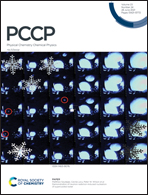The structure of aqueous solutions of hexafluoro-iso-propanol studied by neutron diffraction with hydrogen/deuterium isotope substitution and empirical potential structure refinement modeling†
Abstract
Neutron diffraction measurements of H/D isotopic substitution are made at room temperature for seven H/D substituted hexafluoro-iso-propanol (HFIP; 1,1,1,3,3,3-hexafluoro-2-propanol)–water mixtures at 0.1, 0.2, and 0.4 HFIP mole fraction (xHFIP). The eight partial structure factors except for the H(CH)–H(CH) pair obtained are subjected to an empirical potential structure refinement (EPSR) method to derive all site–site pair correlation functions. It is found that with increasing HFIP concentration the ice-like network of water disappears between xHFIP = 0.1 and 0.2, followed by the formation of a chain-like water structure embedded in an intrinsic structure of HFIP evolved at xHFIP = 0.4. The hydroxyl group of HFIP forms hydrogen bonds with the surrounding water molecules at all HFIP mole fractions investigated. There is no evidence that the water structure is well defined around the CF3 groups of HFIP, but water molecules surround tangentially the CF3 groups of HFIP.



 Please wait while we load your content...
Please wait while we load your content...